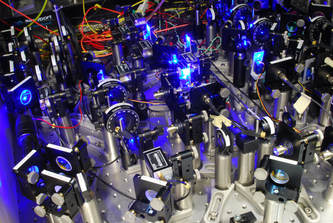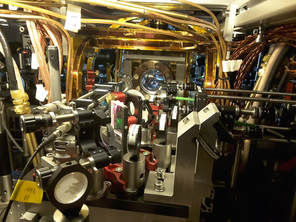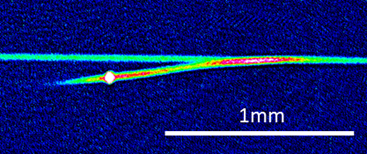Positions in Amsterdam
The Amsterdam team has two open ESR (PhD) projects.
ESR1 - Position filled - Compact atomic sources and beams for steady-state superradiant lasers
Steady-state atomic beam sources are crucial to realizing superradiant clocks and beneficial for quantum sensing with ultracold atoms in general. We have developed a continuous beam of ultracold atoms of unprecedented brightness and phase-space density and can create steady-state samples close to quantum degeneracy (the phase-space density is 1). This continuous source of atoms is one of the foundations of our attempts to develop continuous superradiant clocks within iqClock. The source we have developped so far is rather large and needs to be shrunk in size and complexity to enable more researchers to use them and to bring them out of the lab into the field. We are developing new concepts for generating ultra-cold strontium beams based on compact ovens, 2D MOTs, Grating MOTs and desorption cells. The starting point of ESR1's project will be to develop and compare a range of different technology approaches and to build and characterize the best approach. The ESR will then use the knowledge gained to advance our attempts to build continuous superradiant lasers and possibly even an atom laser. Another aspect of ESR1's work will be to develop advanced laser sources.
ESR2 - Precision laser stabilization and locking
The core of ESR2's project is to develop an ultrastable laser and use it for research. ERS2 will build an ultrastable, high-finesse cavity and lock a laser to it such that it has a linewidth well below 1 Hz. Light will be sent from this laser through phase-stabilized fiber links to the superradiant clock we develop within iqClock and serve to characterize its precision. These characterizations will be used to identify precision limiting effects and to improve the clock. A further research opportunity is to use this laser for internal state control in our programmable quantum simulator. Another aspect of ESR2's work will be the development of a scalable and simple system to lock all lasers required to operate a superradiant clock.
ESR3 - Position filled - High finesse cavities for strong atom-light interaction
High-finesse cavities loaded with ultra-cold atoms are a key to future applications harnessing strong atom-light interactions. These include superradiant optical clocks, sensors, quantum memories, quantum simulation and quantum information processing. As part of our goal of making a steady-state superradiant optical clock we are developing high finesse UHV vacuum cavities that can be loaded with ultracold strontium atoms. For steady-state operation we need to continuously and efficiently load atoms from the ultra-cold strontium beam developed by ESR1 into the cavity. Furthermore the atoms in the cavity need to be held tightly by a magic wavelength lattice, which doesn't shift the Sr clock frequency. ESR3 will work closely with the iqClock team on all these topics.
ESR16 - Position filled - Continual atom delivery to precision clock interrogation zones for zero-deadtime clocks
Advancing clocks to the 10^-18 level and beyond requires precise engineering of the atomic environment. Reducing the integration time of clocks from hours to minutes requires high atom flux, multi-ensemble, zero-deadtime clocks. The ESR will develop and build UHV-compatible interrogation zones that will have a magnetic field shield and a temperature stabilized (10mK) and Peltier cooled (-50°C) black-body shield. These zones should allow interrogation of atomic ensembles at the 10^-18 precision level, undisturbed by a steady-state magneto-optical trap (MOT) operating nearby. The approaches we develop for this work will also be beneficial for more standard and transportable optical clocks, which use only one interrogation zone and pulsed atom loading. In addition, the ESR will develop a new method to continually transfer Sr atoms from a steady-state MOT into four shielded interrogation zones. (S)he will design and build the required moving optical lattice setup. This scheme will be used for a zero-deadtime, high-flux clock, which is able to correct the phase evolution of the local oscillator used for clock interrogation. Thereby it should be possible to average down much faster (as 1/time, not 1/sqrt(time)) than usual clocks, potentially reducing the standard 3 hour averaging time to 2 minutes. This in turn will enable much faster exploration and elimination of effects limiting clock performance. Furthermore those high bandwidth measurements will enable new clock applications (navigation, fundamental physics).
For more information please contact Florian Schreck. Our group webpage is www.strontiumBEC.com and on it you will find further projects, which also have open PhD positions. To apply for one of the ESR positions, go to the vacancies on the UvA website. Candidates will be selected every two months and a new vacancy offer will be posted in case unfilled positions remain.
ESR1 - Position filled - Compact atomic sources and beams for steady-state superradiant lasers
Steady-state atomic beam sources are crucial to realizing superradiant clocks and beneficial for quantum sensing with ultracold atoms in general. We have developed a continuous beam of ultracold atoms of unprecedented brightness and phase-space density and can create steady-state samples close to quantum degeneracy (the phase-space density is 1). This continuous source of atoms is one of the foundations of our attempts to develop continuous superradiant clocks within iqClock. The source we have developped so far is rather large and needs to be shrunk in size and complexity to enable more researchers to use them and to bring them out of the lab into the field. We are developing new concepts for generating ultra-cold strontium beams based on compact ovens, 2D MOTs, Grating MOTs and desorption cells. The starting point of ESR1's project will be to develop and compare a range of different technology approaches and to build and characterize the best approach. The ESR will then use the knowledge gained to advance our attempts to build continuous superradiant lasers and possibly even an atom laser. Another aspect of ESR1's work will be to develop advanced laser sources.
ESR2 - Precision laser stabilization and locking
The core of ESR2's project is to develop an ultrastable laser and use it for research. ERS2 will build an ultrastable, high-finesse cavity and lock a laser to it such that it has a linewidth well below 1 Hz. Light will be sent from this laser through phase-stabilized fiber links to the superradiant clock we develop within iqClock and serve to characterize its precision. These characterizations will be used to identify precision limiting effects and to improve the clock. A further research opportunity is to use this laser for internal state control in our programmable quantum simulator. Another aspect of ESR2's work will be the development of a scalable and simple system to lock all lasers required to operate a superradiant clock.
ESR3 - Position filled - High finesse cavities for strong atom-light interaction
High-finesse cavities loaded with ultra-cold atoms are a key to future applications harnessing strong atom-light interactions. These include superradiant optical clocks, sensors, quantum memories, quantum simulation and quantum information processing. As part of our goal of making a steady-state superradiant optical clock we are developing high finesse UHV vacuum cavities that can be loaded with ultracold strontium atoms. For steady-state operation we need to continuously and efficiently load atoms from the ultra-cold strontium beam developed by ESR1 into the cavity. Furthermore the atoms in the cavity need to be held tightly by a magic wavelength lattice, which doesn't shift the Sr clock frequency. ESR3 will work closely with the iqClock team on all these topics.
ESR16 - Position filled - Continual atom delivery to precision clock interrogation zones for zero-deadtime clocks
Advancing clocks to the 10^-18 level and beyond requires precise engineering of the atomic environment. Reducing the integration time of clocks from hours to minutes requires high atom flux, multi-ensemble, zero-deadtime clocks. The ESR will develop and build UHV-compatible interrogation zones that will have a magnetic field shield and a temperature stabilized (10mK) and Peltier cooled (-50°C) black-body shield. These zones should allow interrogation of atomic ensembles at the 10^-18 precision level, undisturbed by a steady-state magneto-optical trap (MOT) operating nearby. The approaches we develop for this work will also be beneficial for more standard and transportable optical clocks, which use only one interrogation zone and pulsed atom loading. In addition, the ESR will develop a new method to continually transfer Sr atoms from a steady-state MOT into four shielded interrogation zones. (S)he will design and build the required moving optical lattice setup. This scheme will be used for a zero-deadtime, high-flux clock, which is able to correct the phase evolution of the local oscillator used for clock interrogation. Thereby it should be possible to average down much faster (as 1/time, not 1/sqrt(time)) than usual clocks, potentially reducing the standard 3 hour averaging time to 2 minutes. This in turn will enable much faster exploration and elimination of effects limiting clock performance. Furthermore those high bandwidth measurements will enable new clock applications (navigation, fundamental physics).
For more information please contact Florian Schreck. Our group webpage is www.strontiumBEC.com and on it you will find further projects, which also have open PhD positions. To apply for one of the ESR positions, go to the vacancies on the UvA website. Candidates will be selected every two months and a new vacancy offer will be posted in case unfilled positions remain.




